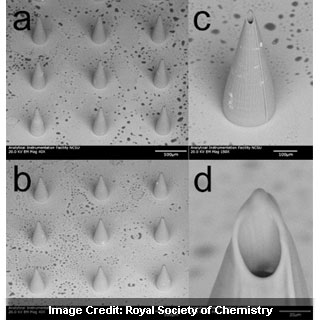
Quantum dots are nanoscale crystals with essential properties with respect to light emission and they may be beneficial as a tool in medical analysis. Scientists formed plastic needles and tested them with the help of pig skin as it has attributes similar to the human skin.
“We were able to fabricate hollow, plastic microneedles using a laser-based rapid-prototyping approach,†commented Dr. Roger Narayan, one of the lead researchers, “And found that we could deliver a solution containing quantum dots using these microneedles.â€
Experts were able to capture images of the quantum dots entering the skin using multiphoton microscopy. This was mainly done with the help of a water-based solution containing quantum dots. The images highlight how the quantum dots enter the layers of the skin. This enables experts to evaluate the efficiency of the microneedles as a delivery mechanism for quantum dots.
“The motivation for the study was to see whether we could use microneedles to deliver quantum dots into the skin,†Narayan added. “Our findings are significant, in part, because this technology will potentially enable researchers to deliver quantum dots, suspended in solution, to deeper layers of skin. That could be useful for the diagnosis and treatment of skin cancers, among other conditions.â€
Multiphoton microscopy may also have clinical applications for real-time imaging of dyes like quantum dots in the skin. This may supposedly help to detect cancer quickly or even help in other medical complications. The study is essential as it highlights a laser-based quick prototyping method which paves a path for the formation of microneedles of different lengths and shapes. This will enables scientists to develop needles that are modified for treatment of a particular condition.
The microneedles were formed with the help of two-photon polymerization. This method was initiated by NC State and Laser Zentrum Hannover for use in medical device applications. Two-photon polymerization enabled experts to develop vacant, plastic microneedles with particular design distinctiveness.
These findings will be published in the September issue of Faraday Discussions.
